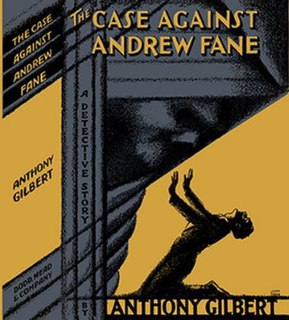
The Case Against Andrew Fane is a 1931 mystery detective novel by the British writer Anthony Gilbert, the pen name of British writer Lucy Beatrice Malleson. It was a stand-alone novel by the author who was at the best time known for her Golden Age detective Scott Egerton.
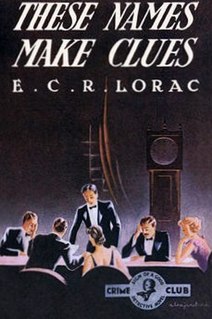
These Names Make Clues is a 1937 detective novel by E.C.R. Lorac, the pen name of the British writer Edith Caroline Rivett. It was the twelfth entry in her long-running series featuring Chief Inspector MacDonald of Scotland Yard. It was written shortly after Lorac had been elected as a member of the Detection Club, and was likely influenced by her experiences there. Originally published by Collins Crime Club, it was reissued in 2021 by the British Library Publishing as part of a group of crime novels from the Golden Age of Detective Fiction.

Fire in the Thatch is a 1946 detective novel E.C.R. Lorac, the pen name of the British writer Edith Caroline Rivett. It is the twenty seventh in her long-running series featuring Chief Inspector MacDonald of Scotland Yard. Originally published by Collins Crime Club, it was reissued in 2018 by the British Library Publishing as part of a group of crime novels from the Golden Age of Detective Fiction.

Murder in the Mill-Race is a 1952 detective novel by E.C.R. Lorac, the pen name of the British writer Edith Caroline Rivett. It is the thirty seventh in her long-running series featuring Chief Inspector MacDonald of Scotland Yard, one of the numerous detectives of the Golden Age of Detective Fiction. It was released in the United States under the alternative title Speak Justly of the Dead. Originally published by Collins Crime Club, it was reissued in 2019 by the British Library Publishing as part of a group of crime novels from the Golden Age of Detective Fiction.
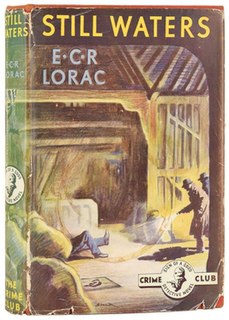
Still Waters is a 1949 detective novel by E.C.R. Lorac, the pen name of the British writer Edith Caroline Rivett. It is the thirty second in her long-running series featuring Chief Inspector MacDonald of Scotland Yard, one of the more orthodox detectives of the Golden Age of Detective Fiction.

The Murder on the Burrows is a 1931 detective story by E.C.R. Lorac, the pen name of the British writer Edith Caroline Rivett. Her debut novel, it introduced the character of Chief Inspector MacDonald of Scotland Yard who went on to appear in a lengthy series of novels during the Golden Age of Detective Fiction. Although initially named James this is changed to Robert in later books. It takes around Bideford Bay in North Devon where the author had spent several holidays.

Shroud of Darkness is a 1954 detective novel by E.C.R. Lorac, the pen name of the British writer Edith Caroline Rivett. It is the thirty ninth in her long-running series featuring Chief Inspector MacDonald of Scotland Yard, one of the more orthodox detectives of the Golden Age of Detective Fiction.

Rope's End, Rogue's End is a 1942 detective novel by E.C.R. Lorac, the pen name of the British writer Edith Caroline Rivett. It is the twenty first in her long-running series featuring Chief Inspector MacDonald of Scotland Yard, a Golden Age detective who relies on standard police procedure to solve his cases. It takes the form of the country house mystery, popular during the era.
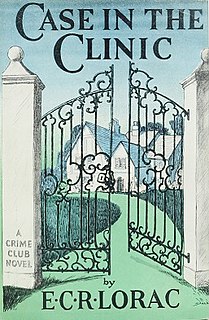
Case in the Clinic is a 1941 detective novel by E.C.R. Lorac, the pen name of the British writer Edith Caroline Rivett. It is the twentieth in her long-running series featuring Chief Inspector MacDonald of Scotland Yard, a Golden Age detective who relies on standard police procedure to solve his cases.

Death of an Author is a 1935 detective novel by E.C.R. Lorac, the pen name of the British writer Edith Caroline Rivett. It is a rare standalone book by Lorac, not featuring Chief Inspector MacDonald of Scotland Yard who appeared in a lengthy series of novels during the Golden Age of Detective Fiction. It was her final novel published by Sampson Low before she switched to the more prestigious Collins Crime Club with whom she remained for the rest of her career.

Murder in Chelsea is a 1934 detective novel by E.C.R. Lorac, the pen name of the British writer Edith Caroline Rivett. It is the seventh book featuring Chief Inspector MacDonald of Scotland Yard who appeared in a lengthy series of novels during the Golden Age of Detective Fiction.

Weekend at Thrackley is a 1934 detective novel by the British writer Alan Melville. A whodunit with comic overtones, it takes the form of a country house mystery, a genre at its height during the decade. His debut novel, it was a commercial success and led to him giving up his job in the timber trade to become a full-time writer. It was reissued in 2018 by the British Library Publishing as part of a group of crime novels from the Golden Age of Detective Fiction.
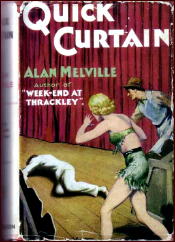
Quick Curtain is a 1934 detective novel by the British writer Alan Melville. It was his second novel following his breakout success with the country house mystery Weekend at Thrackley earlier the same year. It was reissued in 2015 by the British Library Publishing as part of a group of crime novels from the Golden Age of Detective Fiction.

The Case of Colonel Marchand is a 1933 detective novel by E.C.R. Lorac, the pen name of the British writer Edith Caroline Rivett. It is the fourth book featuring Chief Inspector MacDonald of Scotland Yard who appeared in a lengthy series of novels during the Golden Age of Detective Fiction.

Death Knows No Calendar is a 1942 detective novel by the British writer John Bude. It was a stand-alone novel rather than one featuring his regular detective Superintendent Meredith. In this case the investigation is led by a former army officer Major Boddy. It takes the former of a locked room mystery with a closed circle of suspects, both popular variations of the genre during the period. Originally published by Cassell, in 2020 it was reissued by the British Library Publishing in a single edition with another Bude novel Death in White Pyjamas, as part of a series of republished crime novels from the Golden Age of Detective Fiction.

Death on the Riviera is a 1952 detective novel by the British writer John Bude. It was part of a series featuring Superintendent Meredith of Scotland Yard. While Bude set many of his earlier novels in regional England, after the Second World War they made increasing use of more exotic, Continental settings. In 2016 it was reissued by the British Library Publishing as part of a group of republished crime novels from the Golden Age of Detective Fiction.
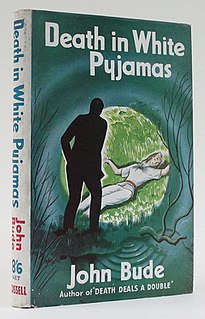
Death in White Pyjamas is a 1944 detective novel by the British writer John Bude. It is a stand-alone novel and does not feature his regular character Superintendent Meredith. Although written during the Second World War, no reference is made to the ongoing conflict. Originally published by Cassell, in 2020 it was reissued by the British Library Publishing in a single edition with another Bude novel Death Knows No Calendar, as part of a series of republished crime novels from the Golden Age of Detective Fiction.
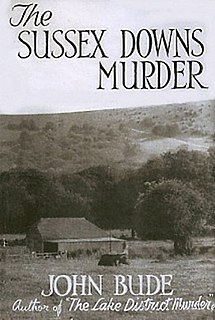
The Sussex Downs Murder is a 1936 detective novel by the British writer John Bude. It is the second novel in a series featuring Superintendent Meredith. He has transferred from the Lake District to the Sussex Constabulary based in Lewes between the novels. Much of the novel takes place around the Chanctonbury Ring. In 2014 it was reissued by the British Library Publishing as part of a group of republished crime novels from the Golden Age of Detective Fiction.

The Lake District Murder is a 1935 detective novel by the British writer John Bude. It is the first in a series of novels featuring Chief Inspector Meredith, promoted at the end of case to Superintendent. Set in the Lake District of Northern England, it shows the influence of Freeman Wills Crofts's Inspector French novels by featuring a detective who methodically breaks down the alibis of his suspects. In 2014 it was reissued by the British Library Publishing as part of a group of republished crime novels from the Golden Age of Detective Fiction.

Death Steals the Show is a 1950 detective novel by the British writer John Bude. It is part of his series of novels featuring Superintendent Meredith.




















